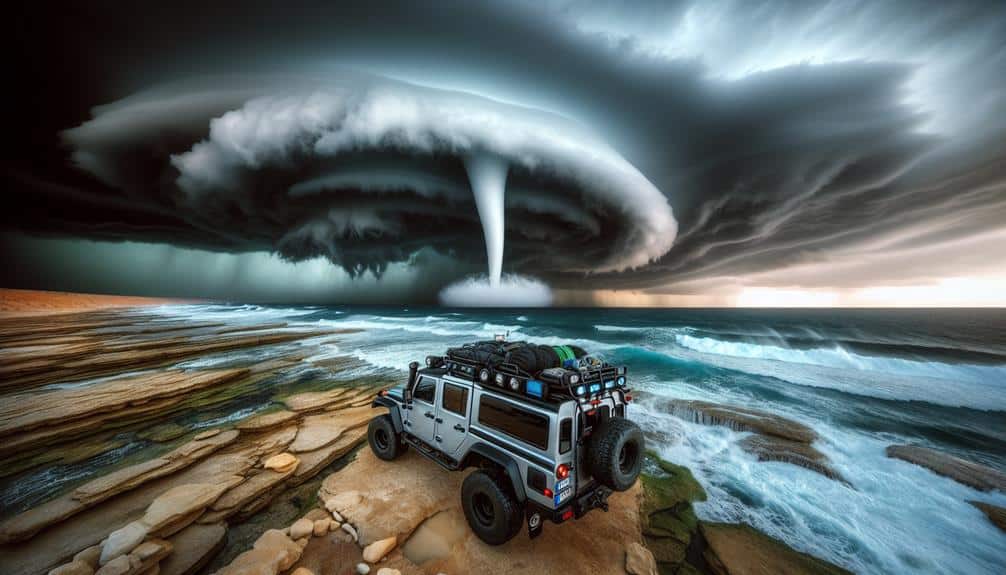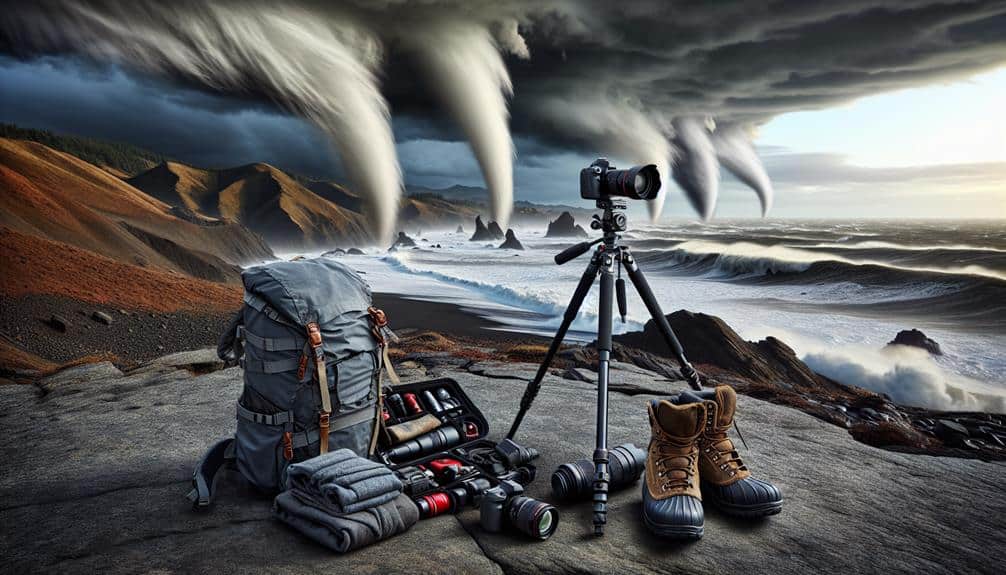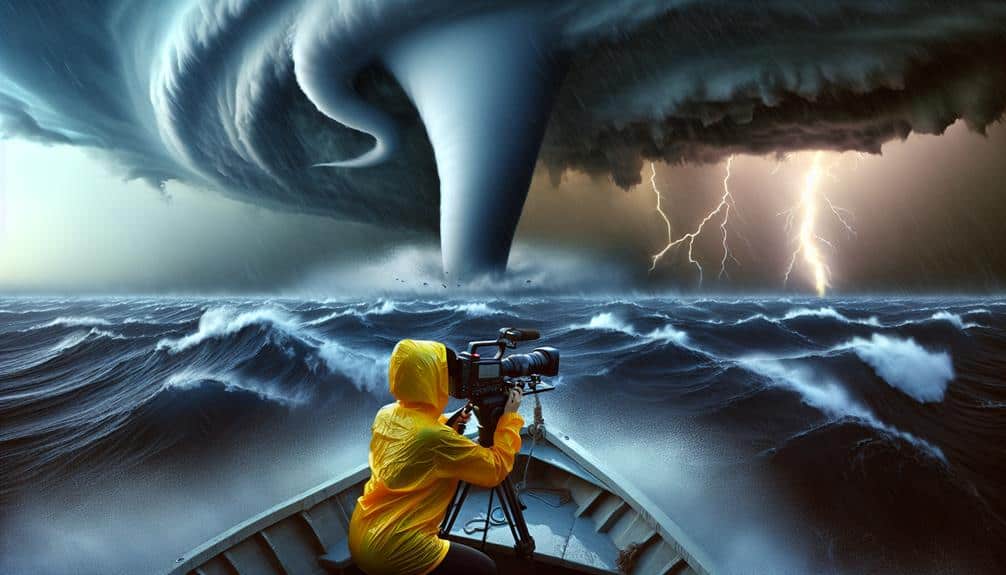As professional storm chasers, we traverse the high seas armed with waterproof cameras and anemometers, fueled by the excitement of capturing waterspouts. We've seen towering cumulus clouds give birth to swirling columns of water, marveled at wind speeds reaching 80 mph, and felt the boat rock as the downdraft hits. Each chase demands meticulous planning, from checking real-time weather data to donning waterproof gear. The thrill intensifies as we position ourselves at the perfect vantage points, ready to immortalize the transient beauty of waterspouts. Our journey is a blend of science, art, and adventure, offering glimpses into natural phenomena like few others.
Key Points
- Professional storm chasers meticulously prepare gear, ensuring waterproof cameras and anemometers are ready for capturing waterspout data.
- Real-time meteorological data guides chasers to potential waterspout formation sites, enhancing chances of capturing stunning footage.
- Safety measures, including life vests and emergency procedures, are crucial for a secure waterspout observation experience.
- High-resolution cameras and precise photography techniques are essential for capturing the dramatic and towering nature of waterspouts.
Understanding Waterspouts
To truly grasp the phenomenon of waterspouts, we first need to understand their formation and the specific atmospheric conditions that give rise to these mesmerizing and potentially dangerous vortices. When we observe a waterspout, we're witnessing a remarkable formation process. Warm, moist air near the water's surface rises and meets cooler air above, creating a rotating column known as a vortex. This vortex can intensify under the right conditions, ultimately forming a waterspout.
From our experiences, waterspouts are often born from towering cumulus clouds, particularly in regions where temperature differences between the water surface and the air above are significant. These conditions are ripe for the rapid development of these spiraling columns of water and air.
One vivid memory we've is spotting a waterspout off the coast of Florida. The sight was simultaneously awe-inspiring and humbling.
However, it's essential to remember that waterspouts can have a significant impact on marine life. Fish and other sea creatures can be lifted into the air, disrupting their natural habitat. Understanding the intricacies of waterspout formation helps us appreciate their beauty while acknowledging their power and the broader implications for marine ecosystems.
Preparing for the Chase
When prepping for our waterspout chase, we need to check that our essential gear checklist is complete, including waterproof cameras and anemometers.
We should also stay tuned to real-time meteorological data and analyze weather patterns to pinpoint potential waterspout formation sites.
I remember a time when our thorough preparation paid off, capturing stunning footage just minutes after arriving on location.
Essential Gear Checklist
Before starting on our exciting waterspout chase, we must carefully assemble an important gear checklist to guarantee both safety and success.
First, gear maintenance is essential. We always inspect our equipment for wear or damage, making sure it's in top condition. Our emergency supplies include a first-aid kit, flares, and a multi-tool—never skimp on these key items. Each item could mean the difference between a minor inconvenience and a serious predicament.
Waterproof clothing is non-negotiable. We opt for breathable yet durable gear, like Gore-Tex jackets and pants. These keep us dry without compromising mobility. Remember, staying comfortable enhances our focus on the chase.
Our camera accessories are equally crucial. We pack multiple lenses, a sturdy tripod, and weatherproof cases to protect our gear from the elements. Spare batteries and memory cards are a must; nothing's worse than running out of power or storage at a vital moment.
Personal experience has taught us the significance of redundancy. A backup GPS, portable battery packs, and laminated maps ensure we never lose our way or miss capturing that perfect shot. With this careful preparation, we're ready to embrace the wild freedom that storm chasing offers.
Analyzing Weather Patterns
Analyzing weather patterns is essential for us to pinpoint the ideal conditions for encountering and safely observing waterspouts. We start by diving into meteorological forecasting, scrutinizing satellite images and radar data to identify potential storm systems. Storm tracking becomes our compass, guiding us toward areas where atmospheric conditions are ripe for storm formation.
In our experience, the magic often happens when we spot a convergence of warm, moist air meeting cooler, drier air. This clash creates the instability needed for waterspouts to form. We've learned to look for low-pressure systems and thunderstorm cells brewing over large bodies of water. These are our red flags.
One memorable chase took us to the Florida Keys. We monitored the atmospheric conditions for days, noting the rising humidity and shifting wind patterns. When the barometric pressure began to drop, we knew we were in for a show.
As predicted, a spectacular waterspout spiraled down from the clouds, dancing on the ocean surface.
Essential Gear and Equipment

To safely navigate and observe waterspouts, we need to equip ourselves with reliable weather monitoring devices and robust marine safety gear. Our first priority is always to make sure our equipment is in top condition. Regular equipment maintenance is essential; it guarantees our anemometers, barometers, and other weather instruments provide accurate data.
We meticulously check our cameras too, adjusting the settings for rapid changes in lighting conditions to capture the perfect shot of a waterspout in action.
Communication devices are our lifelines. Two-way radios and satellite phones keep us connected with our team, especially when cellular networks fail. Navigation tools like GPS systems and marine charts guide us through unpredictable waters, making sure we stay on course.
I remember a particular chase when our equipment's reliability was tested to its limits. The skies darkened, and the winds picked up. Our GPS steered us clear of rough waters, while our cameras, set to a fast shutter speed, captured the mesmerizing beauty of the waterspout without missing a beat.
The thrill of freedom on the open water, coupled with the trust in our gear, makes every chase an unforgettable adventure.
Safety Measures
Staying safe while observing waterspouts demands a thorough understanding of both maritime protocols and weather patterns. It's clear that conducting a risk assessment before heading out is fundamental. Evaluating the likelihood of encountering severe weather conditions helps us prepare mentally and physically.
We always have detailed evacuation plans in place, ensuring we're well-prepared and know the quickest routes to safety should a waterspout change course unexpectedly. Our safety protocols also include wearing life vests and having a reliable communication system onboard. We use VHF radios to stay in constant contact with the Coast Guard and local weather stations. Being aware of our exact location at all times is essential, so GPS devices are non-negotiable.
Emergency procedures are second nature to us. For instance, when a waterspout forms nearby, we immediately secure all loose items and turn the boat's bow into the wind. This minimizes the risk of capsizing. We've practiced these drills countless times, making our responses instinctive rather than reactive.
Personal anecdotes remind us why these measures are crucial. Once, a rapidly forming waterspout forced us to execute our evacuation plan within minutes. Our preparedness turned a potentially disastrous situation into a controlled retreat, underscoring the significance of meticulous planning.
Capturing the Perfect Shot

When it comes to capturing the perfect shot of a waterspout, we rely on a combination of high-resolution cameras, precise timing, and a deep understanding of the ideal vantage points. Our photography techniques are honed through countless hours of trial and error. We've learned that shutter speed and aperture settings can make or break the shot. Balancing these with the unpredictable movement of a waterspout is nothing short of exhilarating.
Positioning ourselves at the right angle to capture unique perspectives of the storm dynamics is essential. We've often found that shooting from a low angle emphasizes the towering nature of these spiraling phenomena, enhancing the sense of scale and power. The adrenaline rush that comes from being so close to nature's fury is indescribable.
One of our most memorable experiences involved racing against time to catch the perfect light as the sun set behind a monstrous waterspout. The golden hour added a surreal glow, turning an already dramatic scene into something almost otherworldly.
In moments like these, our deep understanding of both the technical aspects of photography and the ever-changing storm dynamics pays off, allowing us to freeze these fleeting moments in time.
Memorable Waterspout Encounters
Among our many adventures, one encounter with a waterspout off the coast of Key West stands out for its sheer intensity and dramatic impact on our senses. The stormy seas roared beneath us, and the air was thick with the smell of salt and electricity. As we navigated our boat closer, we could feel the raw power of nature. The waterspout twisted and churned, a mesmerizing dance of wind and water.
We quickly set up our cameras and instruments, excited to capture this breathtaking beauty.
Here are a few unforgettable moments from that day:
- Formation: Watching the waterspout form from a cumulus cloud, the initial downdraft hitting the ocean surface, was a sight to behold.
- Close Proximity: We managed to get within a safe but thrilling distance, feeling the spray and hearing the hiss of the rotating column.
- Data Collection: Using anemometers and barometers, we recorded wind speeds exceeding 80 mph and pressure drops that made our ears pop.
- Disintegration: The moment when the waterspout dissipated, leaving behind a tranquil sea, was almost surreal.
This encounter reminded us why we chase these natural phenomena: the thrill, the science, and the unparalleled beauty.
Frequently Asked Questions
How Do You Emotionally Prepare for Potentially Dangerous Storm Chasing?
We mentally prepare for storm chasing by focusing on safety precautions and facing fears head-on. The adrenaline rush fuels us as we review technical terminology, share personal anecdotes, and embrace the freedom of the unknown.
What Inspired You to Become a Professional Storm Chaser?
We watched thunderstorms rolling over vast plains, the sky painted with electric veins and thunderous roars. Our personal motivation stemmed from childhood dreams of capturing nature's raw power, leading us to master meteorological data and storm dynamics.
How Do You Balance Storm Chasing With Your Personal Life?
Balancing storm chasing with personal life requires meticulous time management and setting priorities. We maintain work-life balance by establishing clear boundaries. We've learned to cherish downtime and use technical tools to streamline our storm-chasing schedules.
Have You Ever Faced Any Close Calls or Life-Threatening Situations?
Like riding the edge of a lightning bolt, we've faced close calls. Our safety precautions and emergency protocols keep us steady. The adrenaline rush fuels us, but mental resilience is key to maneuvering life-threatening situations.
What Do You Do When You're Not Chasing Storms?
When we're not chasing storms, we indulge in hobbies like photography and hiking. Our downtime often includes relaxation through reading weather journals and exploring new interests like drone technology. Embracing freedom fuels our passion for new adventures.


